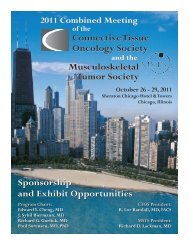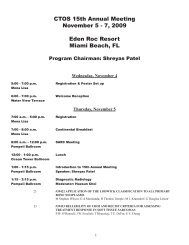Scientific <strong>Poster</strong>s – <strong>Poster</strong> <strong>Session</strong> 2<strong>Poster</strong> #165HDAC INHIBITION; A NOVEL THERAPY FOR THETREATMENT OF EPITHELIOID SARCOMAGonzalo Lopez 1 ; Yechun Song 1 ; Quan-Sheng Zhu 1 ;Ryan Lam 1 ; Roman Belousov 1 ; Davis R. Ingram 1 ;Torsten O. Nielsen 3 ;Chad Creighton 2 ; Dina Lev 11MDACC, Houston, TX, USA; 2 Baylor College of Medicine,Houston, TX, USA; 3 University of British Columbia,Vancouver, BC, CanadaObjective: There is a critical need for improved therapeuticstrategies for the treatment of epithelioid sarcoma (ES).Loss of INI1 expression is the molecular hallmark of theseunique malignancies resulting in a potential disruption inthe cellular epigenetic landscape. The goal of the currentstudy was to evaluate the effects of the epigenetic modifiers,HDAC inhibitors (HDACi), on the protumorigenicproperties of ES cells in vitro and in vivo.Methods: Three human ES cell lines were included(VAESBJ, Epi544, and HS-ES) and three HDACis weretested (PCI24781, SAHA, and MS275). Effects on growthwere assessed by MTS and clonogenic assays; cell cycleprogression was determined by PI staining FACS analysesand apoptosis by Annexin V/PI FACS analysis and WBfor cleaved caspase 3 and cleaved PARP. In vivo growtheffects of PCI24781 were evaluated using SCID mouse ESxenograft models. An Illumina gene array was used todetermine HDACi-induced gene expression signatures.Genes of interest were validated via WB and qPCR.Results: HDACis induced target acetylation in ES cellsand abrogated their growth and colony formation. Furthermore,G2 cell cycle arrest and enhanced apoptosis wasnoted. PCI24781 markedly inhibited ES xenograft growthand induced apoptosis in vivo. Gene expression profilingidentified an ES HDACi-induced genetic signature consistingof multiple up- and down- regulated genes (~5%of genes on the platform exhibited reproducibly changedexpression). Bioinformatic analyses identified enrichmentof genes associated with cell death, cell cycle progression,and differentiation. Furthermore, multiple transcriptionalregulators, epigenetic modifiers, and post-translationaleffectors were found to exhibit changed expression, highlightingthe complexity of- and the interaction amongstnodesmaking up the cellular molecular landscape. Ourstudies further demonstrated HDACi induced reduction inthe expression of one particular epigenetic enzyme, EZH2.Enhanced EZH2 expression was demonstrated in humanES specimens and studies to unravel the pro-ES effects ofthis protein are currently ongoing.Conclusion: Studies presented here identified moleculesof potential contribution to the development and progressionof ES. Most importantly, pre-clinical investigationsidentified HDAC inhibition as a possibly effective anti-EStherapeutic strategy supporting further investigation ofthis approach in the clinical setting.<strong>Poster</strong> #166TRABECTEDIN ACTIVITY IN SOFT TISSUESARCOMAS OF VASCULAR AND PERIVASCULARCELLS (STS-V/PV): A RETROSPECTIVE POOLEDANALYSISJean-Yves Blay 1 ; Ian Judson 2 ; Robert G. Maki 3 ;Xavier García del Muro 4 ; María José Pontes 5 ; Patrik Zintl 5 ;George D. Demetri 61Centre Leon Berard, Lyon, France; 2 Royal Marsden Hospital,London, United Kingdom; 3 Sloan-Kettering Institute,New York, NY, USA; 4 Institut Catala d’Oncologia, Barcelona,Spain; 5 PharmaMar, Madrid, Spain; 6 Dana-Farber CancerInstitute, Boston, MA, USAObjective: Trabectedin is approved in >70 countries worldwidefor the treatment of advanced soft tissue sarcomas(STS). It has demonstrated activity in several phase IIstudies as well as compassionate use programs. STS-V/PVrepresent 3 cycles).One patient with solitary fibrous tumor achieved partialresponse (8%), 5 patients had stable disease (39%; in 4 lasting≥3 months), 7 patients (54%) had progressive disease asbest response. Median PFS was 1.9 months (CI95%:1.5-3.3)and 38.5% patients (CI95% 12-64.9) were progression-freeat 3 months. Median OS was 8.8 months; OS at 12 and 24months was 40.5% (CI95% 8-72.9) and 27% (CI95% 0-57.5),respectively. There were no unexpected toxicities: grade3/4 toxicities included neutropenia (58% of the patients),thrombocytopenia (25%), anemia (8 %), fatigue (8%),254
Scientific <strong>Poster</strong>s – <strong>Poster</strong> <strong>Session</strong> 2anorexia (8%), and transient and asymptomatic grade3/4 ALT and AST elevations in 62% and 33% of patients,respectively.Conclusion: Trabectedin appears to be an active drug forpatients with advanced STS-V/PV with tolerability similarto other forms of STS and solid tumors. The results of thisretrospective analysis are in the range of other marketeddrugs used in first line chemotherapy. However, further,prospective studies are warranted.<strong>Poster</strong> #167EFFICACY OF TRABECTEDIN IN ADVANCEDSOFT TISSUE SARCOMA: BEYOND LIPO- ANDLEIOMYOSARCOMARita De Sanctis, MD 1 ; Alexia F. Bertuzzi 1 ; Milena Gasco 1 ;Carolina Cauchi 1 ; Fabio Romano Lutman 2 ; Laura Giordano 3 ;Vittorio Quagliuolo 4 ; Armando Santoro 11Department of <strong>Oncology</strong>-Haematology, Humanitas CancerCenter, IRCCS, Rozzano (Milan), Italy;2Department of Radiology, Humanitas Cancer Center, IRCCS,Rozzano (Milan), Italy; 3 Biostatics Unit, Humanitas CancerCenter, IRCCS, Rozzano (Milan), Italy; 4 Department ofSurgical <strong>Oncology</strong>, Humanitas Cancer Center, IRCCS,Rozzano (Milan), ItalyObjective: Trabectedin (T), a marine-derived compound,is effective in patients (pts) with leiomyosarcoma or liposarcoma,especially myxoid liposarcoma, related to thepresence of the FUS-CHOP transcript. We reviewed ourmono-institutional series of advanced STS treated with Tto evaluate its efficacy in specific subgroups.Methods: Since March 2008 through May 2012, 35 pts withadvanced anthracycline-pretreated STS received T at a doseof 1.5 mg/m2 every 3 weeks by continuous 24 h infusion.We evaluated, as primary endpoints, best response rate accordingto RECIST criteria and severe adverse events (AEs)according to NCI-CTCAE v4.02. Secondary endpoints includedProgression-Free (PFS) and Overall Survival (OS).Kaplan-Meier method was used to estimate PFS and OS.Results: Median age was 46 years (range, 20-61). MedianECOG PS was 0. Median follow-up time was 8 months(range, 2-23). The median number of previous chemotherapyregimens was 1 (range, 0-5). Median number of Tcycles was 2 (range 1-6). 28/35 (80%) pts were evaluablefor response: 2 pts (7%) achieved partial response and 10(36%) stable disease. Median duration of response to T was2.8 months (95% CI, 1.2-4.6). According to histotype, clinicalbenefit (PR+SD) was reported in synovial sarcoma (4 pts),retroperitoneal liposarcoma (4 pts), leiomyosarcoma (2pts), Ewing/pPNET (1 pt) and high grade NOS STS (1 pt).Toxicity profile confirmed literature data. Any grade AEseffects were non-cumulative, reversible and manageable.G3/G4 AEs included anemia (1 pt, 3%), neutropenia (2 pts,6%), pancitopenia (3%) and liver toxicity (3%). There wasno toxic death or suspension due to toxicity. Median PFSof the entire cohort was 2.5 months (CI 95% 2-5.4) and OS15.5 months (CI 95% 12-17.6).Conclusion: Although limited, our experience confirmsthat T is an effective therapeutic option for metastaticlipo- and leiomyosarcoma pts. Furthermore, it could be apromising option also in synovial sarcomas. T mechanismof action may be related to the presence of specific translocations.Therefore, further integrated studies of molecularbiology and pharmacology are required.<strong>Poster</strong> #168IMATINIB MESYLATE IN DESMOPLASTIC SMALLROUND CELL TUMOURAlexia F. Bertuzzi 1 ; Gianni Bisogno 2 ; Modesto Carli 2 ;Andrea Ferrari 3 ; Alessandro Comandone 4 ; Milena Gasco 1 ;Rita De Sanctis 1 ; Chiara Gnocchi 5 ; Armando Santoro 11Department of <strong>Oncology</strong>-Haematology, HumanitasCancer Center, IRCCS, Rozzano (Milan), Italy; 2 Departmentof Pediatrics, Clinica di Onco-Ematologia Pediatrica, Padova,Italy; 3 Department of Pediatric <strong>Oncology</strong>, Fondazione IRCCS- Istituto Nazionale dei Tumori, Milan, Italy; 4 Departmentof Medical <strong>Oncology</strong>, Presidio Sanitario Gradenigo, Turin,Italy; 5 Novartis Farma, Origgio, ItalyObjective: Desmoplastic small round cell tumor (DSRCT)is a very rare and aggressive mesenchymal neoplasm withpoor prognosis. The typical translocation t(11;22) determinesthe overexpression of PDGF-Rα and β, responsibleof the stromal fibrosis which is constantly detected inabdominal lesions. On this rationale, we investigated thepossible role of imatinib, as tyrosine kinase inhibitor ofPDGF-R, in DSRCT.Methods: From August 2005 to June 2009 we enrolled patients(pts) with histologically proven diagnosis of DSRCT,refractory to conventional treatment. Inclusion criteriacomprised immunohistochemical positivity of imatinibtargets (PDGF-Rα and β). Patients received imatinib 400mg p.o. daily. Primary endpoint of the study was objectiveresponse rate. Secondary endpoint was safety and tolerabilityprofile.Results: Of the 13 enrolled patients, 8 pts were evaluablefor response (4 screening failure and 1 never treated).Median age was 20 years (range, 9-32). M/F ratio was7/1. ECOG PS was 0 in 6 pts. Median time from diagnosiswas 24.5 months (range, 6-148). 75% of pts had metastaticdisease. The primary site was abdominal-pelvic for all pts.PDGFRα and β were expressed with an heterogeneous255






